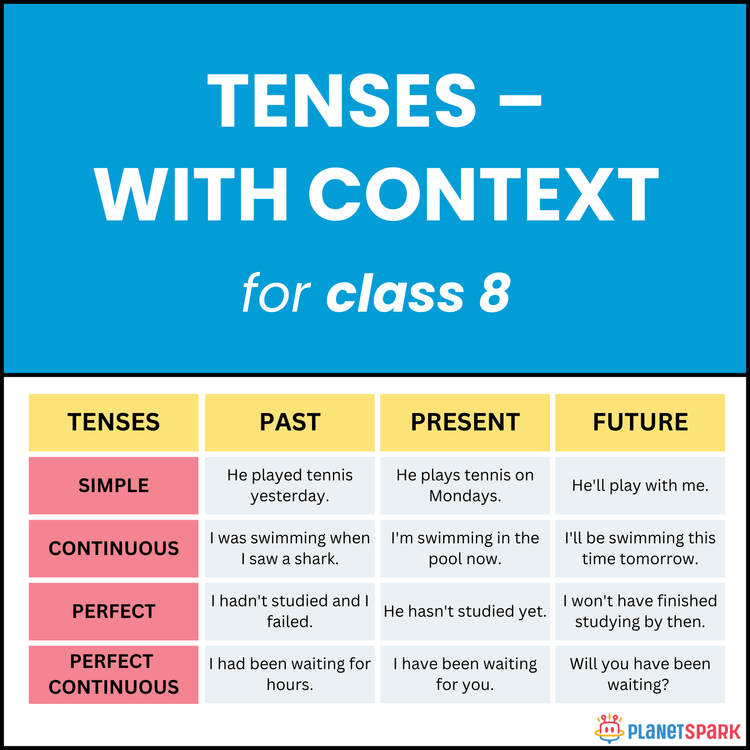How to Identify Tenses in English Grammar | Easy Guide

Understanding how to identify tenses is one of the most essential parts of learning English grammar. Tenses form the foundation of all communication , they help us express when something happened, what is happening now, or what will happen in the future.
In this detailed guide, you’ll learn how to identify tenses in sentences, recognize the different tense types and forms, and apply them correctly in daily communication. We’ll also explore how identifying tenses can improve your writing, reading, and speaking skills.
Understanding the Basics of Tenses
Before you can identify tenses, you need to understand what tenses actually represent.
What Are Tenses?
Tenses are grammatical tools that indicate the time of an action or state. Every sentence you form in English , whether it describes an event, feeling, or thought , contains a verb that reveals when it happens.
There are three main time frames in English grammar:
Past Tense: Refers to actions that already happened.
Present Tense: Describes actions happening right now or that occur regularly.
Future Tense: Indicates actions that will happen later.
Each of these three tenses has four aspects , Simple, Continuous, Perfect, and Perfect Continuous , making a total of 12 tenses in English.
Mastering these 12 forms will help you accurately express time, intention, and completion of actions.

How to Identify Tenses in Sentences
Learning how to identify tenses starts with recognizing patterns in verb forms, helping verbs, and time indicators. Here’s a step-by-step breakdown:
Step 1: Observe the Main Verb
The main verb is the heart of every tense. By observing its form, you can usually tell which tense the sentence uses.
Base verb (walk, go, read) → Present Simple
Past verb (walked, went, read) → Past Simple
Will + verb (will go, will read) → Future Simple
Example:
I walk every morning. → Simple Present
I walked yesterday. → Simple Past
I will walk tomorrow. → Simple Future
Step 2: Identify Helping Verbs (Auxiliaries)
Helping verbs show the tense and aspect of the action.
| Helping Verb | Example | Tense Type |
|---|---|---|
| am/is/are + verb-ing | She is reading. | Present Continuous |
| was/were + verb-ing | She was reading. | Past Continuous |
| will be + verb-ing | She will be reading. | Future Continuous |
| has/have + past participle | He has finished. | Present Perfect |
| had + past participle | He had finished. | Past Perfect |
| will have + past participle | He will have finished. | Future Perfect |
These auxiliary verbs clearly signal which tense is being used.
Step 3: Look for Time Expressions
Time indicators often reveal the tense. For instance:
Yesterday, ago, last night → Past
Now, today, every day → Present
Tomorrow, next week, in the future → Future
Example:
I studied yesterday. → Past
I am studying now. → Present
I will study tomorrow. → Future
Step 4: Check Verb Combinations for Aspect
Some tenses combine auxiliary and main verbs to show how an action extends or completes over time.
Examples:
I have been studying for two hours. → Present Perfect Continuous (ongoing since past)
He had been working before he moved. → Past Perfect Continuous (action continued until another past event)
They will have been waiting for an hour by 6 PM. → Future Perfect Continuous (ongoing up to a future point)
These combinations indicate both time and duration.

The 12 English Tenses
Let’s explore how to identify all twelve tenses with examples, structures, and identification clues.
1. Simple Present Tense
Structure: Subject + base verb / s/es
Example: He plays football.
How to Identify: Look for base form verbs or verbs ending with s/es. It expresses daily habits or general truths.
2. Present Continuous Tense
Structure: Subject + am/is/are + verb-ing
Example: She is studying now.
How to Identify: Presence of am/is/are + verb-ing form. Describes actions happening right now.
3. Present Perfect Tense
Structure: Subject + has/have + past participle
Example: They have completed the work.
How to Identify: Look for has/have + past participle. Describes completed actions relevant to the present.
4. Present Perfect Continuous Tense
Structure: Subject + has/have been + verb-ing
Example: He has been working since morning.
How to Identify: Has/have been + verb-ing shows ongoing action starting in the past and continuing now.
5. Simple Past Tense
Structure: Subject + past form of verb
Example: He watched a movie yesterday.
How to Identify: Past verb forms like played, went, worked.
6. Past Continuous Tense
Structure: Subject + was/were + verb-ing
Example: They were singing when I arrived.
How to Identify: Was/were + verb-ing indicates an ongoing past action.
7. Past Perfect Tense
Structure: Subject + had + past participle
Example: She had left before I came.
How to Identify: Had + past participle shows one action finished before another past event.
8. Past Perfect Continuous Tense
Structure: Subject + had been + verb-ing
Example: He had been waiting for hours before the train came.
How to Identify: Had been + verb-ing shows continuous action before another past event.
9. Simple Future Tense
Structure: Subject + will/shall + verb
Example: She will dance tomorrow.
How to Identify: Will/shall + base verb shows future action.
10. Future Continuous Tense
Structure: Subject + will be + verb-ing
Example: He will be traveling next week.
How to Identify: Will be + verb-ing expresses future ongoing actions.
11. Future Perfect Tense
Structure: Subject + will have + past participle
Example: She will have finished her work by 5 PM.
How to Identify: Will have + past participle indicates completion before a future point.
12. Future Perfect Continuous Tense
Structure: Subject + will have been + verb-ing
Example: By next year, I will have been teaching for a decade.
How to Identify: Will have been + verb-ing emphasizes action duration until a future time.
Quick Tip to Identify Tenses in Seconds
Ask yourself:
When is the action happening , past, present, or future?
Is it continuous, completed, or ongoing?
The answers will instantly tell you which tense you’re dealing with.
Why Learning to Identify Tenses Is Crucial
Knowing how to identify tenses improves:
Writing clarity: Helps form grammatically correct sentences.
Speaking fluency: Makes your speech natural and accurate.
Reading comprehension: Enables you to interpret text correctly.
Listening skills: You understand the timeline of events clearly.
When you can confidently recognize tenses, you can express thoughts precisely , a key skill in both academics and professional life.
To strengthen these skills practically, PlanetSpark’s Spoken English Course helps students identify and use tenses in real-time conversations, storytelling, and dialogue-based exercises!
How PlanetSpark’s English Grammar Course Builds Mastery in Tenses
Interactive Grammar Learning
Instead of memorizing rules, students learn through stories, dialogues, and role plays that make tenses come alive in context.
Gamified Learning Tools
Children engage with grammar quizzes, puzzles, and interactive games, turning tense identification into fun challenges.
Integrated Writing Practice
Each grammar lesson is followed by sentence-building and writing tasks, helping students apply what they learn instantly.
Grammar Proficiency Levels
Students advance gradually from basic grammar (nouns, verbs, punctuation) to advanced grammar (conditionals, passive voice, reported speech) with clear milestones.
Parent Reports and Progress Tracking
Parents receive detailed reports tracking growth in writing fluency, grammar accuracy, sentence complexity, and logical flow.
1:1 Personal Trainers for Every Child
Every child learns with a certified communication trainer who provides personalized feedback during live sessions. These mentors adapt lessons to each student’s learning pace, ensuring deeper understanding.
Personalized Learning Roadmap
Each student’s journey begins with a skill assessment that helps PlanetSpark create a custom grammar roadmap focusing on tenses, vocabulary, and sentence structure improvement.
SparkX – AI-Enabled Video Analysis
With AI-powered analysis, students receive instant feedback on grammar usage, sentence fluency, and body language during recorded sessions.
AI-Led Practice Sessions
PlanetSpark’s AI coach allows students to practise speeches, storytelling, and grammar exercises outside class with real-time corrections.
Clubs and Learning Communities
From Debate Clubs to Storytelling Circles, kids apply grammar in meaningful, social learning settings that build confidence and creativity.
If you want your child to truly understand grammar and not just memorize it , join PlanetSpark’s English Grammar Course today and see how fun and personalized English learning can be!
Rise Above Grammar Confusion: Learn Tenses the Smart Way
Mastering how to identify tenses is not about memorizing rules , it’s about understanding patterns, usage, and the logic of language. Once you learn to recognize verb forms, auxiliaries, and time cues, identifying tenses becomes effortless.At PlanetSpark, grammar is not taught , it’s experienced. Through personalized 1:1 mentorship, gamified tools, and AI-powered feedback, children learn to think, speak, and write in English with confidence and accuracy.
You may also read:
Frequently Asked Questions
To identify tense in a sentence, look at the verb form, helping verbs, and time markers.
If the verb is in its base form (go, play) → Present Tense.
If it’s in the past form (went, played) → Past Tense.
If it includes “will” or “shall” → Future Tense.
Also, words like yesterday, now, tomorrow, or for years help determine whether the action is past, present, or future.
There are 12 tenses in English, divided across three time frames:
Present: Simple Present, Present Continuous, Present Perfect, Present Perfect Continuous
Past: Simple Past, Past Continuous, Past Perfect, Past Perfect Continuous
Future: Simple Future, Future Continuous, Future Perfect, Future Perfect Continuous
Each shows the time and nature of an action — whether it’s ongoing, completed, or repetitive.
The easiest way to learn tenses is by practising sentence formation daily and connecting grammar with real-life examples. Instead of memorizing, focus on usage-based learning.
Courses like PlanetSpark’s English Grammar Course make it simple through interactive games, storytelling, and AI feedback, helping students remember and apply tenses naturally.
Identifying tenses is crucial because it ensures clarity and accuracy in communication. It helps you express when an action happens — improving writing, speaking, and reading skills.
In schools and exams, tense identification also strengthens your grammar foundation, helping you avoid common errors in essays, stories, and speeches.
PlanetSpark helps students master tenses through interactive grammar lessons, gamified exercises, and personalized 1:1 sessions with expert trainers.
Children learn to identify and use tenses in real-world communication, storytelling, and creative writing — making grammar fun, practical, and confidence-boosting.
Download Free Worksheets
Personalized Communication Report
Record a video to get a AI generated personalized communication report for your child

Hi There, want to try these
tips for your child with
LIVE with our expert coach?
Let's check your child's
English fluency

